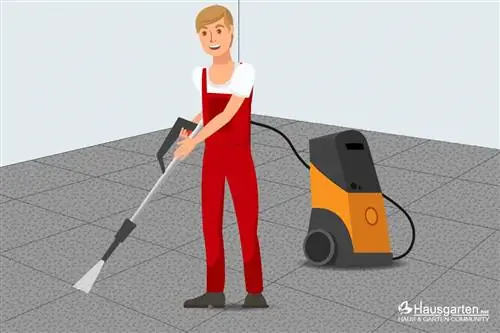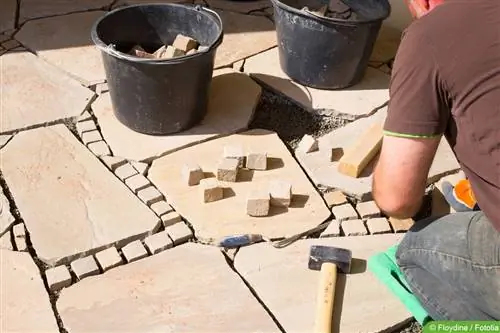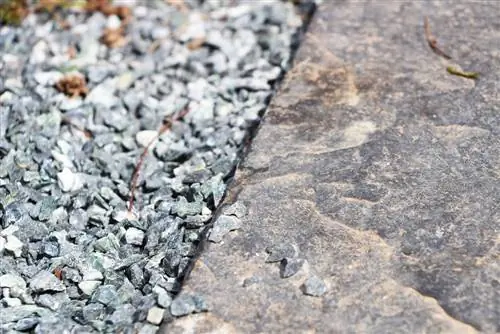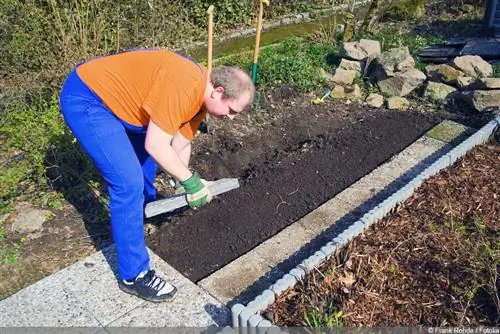- Author admin [email protected].
- Public 2023-12-17 03:39.
- Last modified 2025-01-24 12:45.
If you want to create a garden path, you should prepare the surface properly. More time should be invested in the substructure, especially in heavily used paths such as driveways. We'll show you how to do it correctly.
Which garden path in which place?
That has to be decided first, because the substructure has to meet very different requirements for very different garden paths. And when you plan your garden path in more detail, you could experience a few surprises. For example, you might find that the garden path in the rear area of the property should be best accessible so that you can easily load the apple harvest for the cider operation and the remaining material that needs to be taken away into the car. The path through the garden itself is designed to withstand a fully loaded wheelbarrow in certain areas, but in certain areas it will only be used every few days at most. Then it depends on whether your property has height differences that may even require the construction of stairs in certain places.
With a larger property, the more precise planning quickly results in a whole network of paths, all of which have to withstand different loads. There can be main paths and connecting paths, an extra path from the terrace to the seating area (with steps) and a romantic winding path through the lawn. Some of these garden paths will be quite straight, some will serve more as a decorative structure to the garden and should definitely not be dead straight. Each of these paths will now have exactly the right substructure when the planning is finished:
The different types of base for a garden path
- A path that is to be traveled by a motor vehicle (and perhaps by a truck delivering oil) needs a multi-layer, load-bearing and carefully compacted substructure.
- The main path through the garden has to carry a wheelbarrow, which may be loaded with heavy building materials for some kind of garden building. It should also have a durable substructure made up of several layers that is particularly compacted.
- The path away from the house must be provided with a substructure that leads the rainwater away from the house; the substructure must also meet certain infiltration requirements. Otherwise: Several layers, matching the respective plaster.
- Narrow, decorative paths can be equipped with different surfaces, each with a specific substructure, usually just a little gravel or gravel. Only if garden paths are to be laid out on newly filled land do you need to pay particular attention to the compaction of the subsoil.
- Paths with loose coverings such as bark mulch are given a layer of root protection fleece on the substructure, so they look “tidy” for much longer.
- The garden paths, which can actually no longer be called “paths” because they only consist of individual stepping stones, do not need any substructure at all. With such footpaths, however, you should be aware that they will certainly change over time; the stones will probably be quite crooked and crooked at some point. Definitely not the right surface for people who are not in their prime and/or show insecurities when running!
The absolutely natural garden path without a substructure
If you have taken over a well-vegetated natural plot in which you would actually prefer not to create a (visible or eye-catching) path at all, you could use a special trick: you set a route that is also You could walk through tall bushes by sticking small stakes with barrier tape into the ground on both sides. Then you should check the route to see if there are any roots that would encourage you to move the route rather than dig it up. Now everything that grows between the pegs has to be removed so that you can drive along the route with the lawnmower. If you're lucky, you'll only have to cut the entire vegetation of herbs, grass and young tree shoots down to a height of around 20 cm, i.e. until the lawn mower can handle it. This also means regular maintenance of this garden path: mow it once every two weeks in summer, and you're done! Of course, you will also save a lot of money, and such a route works better on any reasonably level property than the solution with stepping stones.
Tips for the substructure
Gravel, gravel and sand are generally used as a substructure. And this is for the following reason: Since there are gaps in the gravel and gravel, the water can drain away easily. In addition, gravel does not give in even under heavy loads.
Depending on how deep the excavation is, you have to fill it with crushed stone and gravel. The layer of gravel should be a maximum of 10cm high, the gravel layer 3cm and on top of that a bed of sand in which the stones are stored.
If the joints are to be sealed and the water cannot seep away directly, a gradient must be provided that drains the water away. The slope should always face away from the house if the path runs along the house wall. A minimum gradient of 2-3° is sufficient. You should use the spirit level to check the gradient approximately every meter.
Once this work is done, it's almost time to start paving. But first you should be clear about which pattern or type of bandage you want to use.






